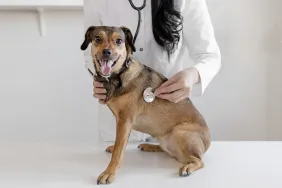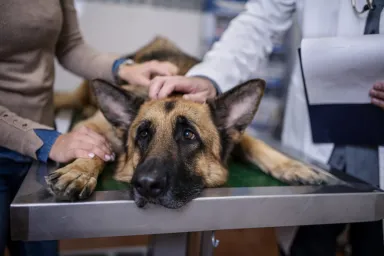
Paralysis In Dogs: Symptoms, Causes, & Treatments
Paralysis in dogs happens when the central nervous system’s ability to coordinate the body’s movements is diminished or completely lost.

Paralysis in dogs happens when the central nervous system’s ability to coordinate the body’s movements is diminished or completely lost.

Syncope is the medical term for fainting, which happens when dogs lose consciousness, usually due to a lack of oxygen and nutrients normally provided to the brain by blood flow. The fainting spells are usually brief in dogs and followed by spontaneous recovery.

Cyanosis in dogs is a medical condition that can cause a dog’s skin and mucus membranes to turn a blue color. It happens when red blood cells cannot carry sufficient oxygen around the body. The condition can often result from an underlying heart or respiratory system disease. The prognosis for dogs is often poor, so you must seek help from a veterinarian early on if you notice symptoms. Here’s what you should know about the symptoms, causes, and treatments of cyanosis in dogs.

Ascites, also known as abdominal effusion or free abdominal fluid, is a serious medical condition in dogs in which there is an abnormal buildup of fluid in the abdomen. Many possible medical conditions would cause such a buildup, and even though it can be treated, it’s likely to return if the underlying condition remains.

Thrombocytopenia in dogs is a medical condition where the number of platelets, also known as thrombocytes, circulating in the blood becomes too low. A low platelet count can lead to problems like spontaneous bruising and bleeding. Thrombocytopenia is a common condition in dogs, and as many as five percent of all dogs who come into veterinary hospitals have it. It can be a condition on its own, or it can be a sign of another underlying medical problem.

Uremia in dogs is a serious medical emergency that happens when waste products and toxins that are normally filtered by the kidneys build up in the bloodstream where they can spread throughout the body. This can occur when the kidneys suffer damage or when obstructions appear in the urinary tract.

Acid reflux in dogs, also called gastroesophageal reflux disease, happens when the acid and enzymes from the stomach and intestines that aid in digestion move into the esophagus. While the symptoms aren’t particularly life-threatening, they can cause discomfort. They can also be dangerous, as the acidic contents of the digestive system can wear away at the lining of the esophagus over time, leading to ulcers.

Open fontanel refers to a condition where the affected dog has a hole in their skull due to the dog’s bone junctions not fusing properly. Because of this hole, the brain may be exposed to injuries, and the hole might also contribute to hydrocephalus.

Renal or kidney failure in dogs happens when the kidneys are no longer able to properly filter nitrogen and other waste from the bloodstream. It’s imperative to learn the signs of kidney dysfunction, along with the causes and treatments, in order to know how best to help your dog if they begin showing any symptoms. An early diagnosis can be key in protecting your pup’s long-term outcome.

Bloat in dogs is a life-threatening condition where the stomach fills with gas and, in some cases, rotates, which puts pressure on other organs and traps blood in the stomach.